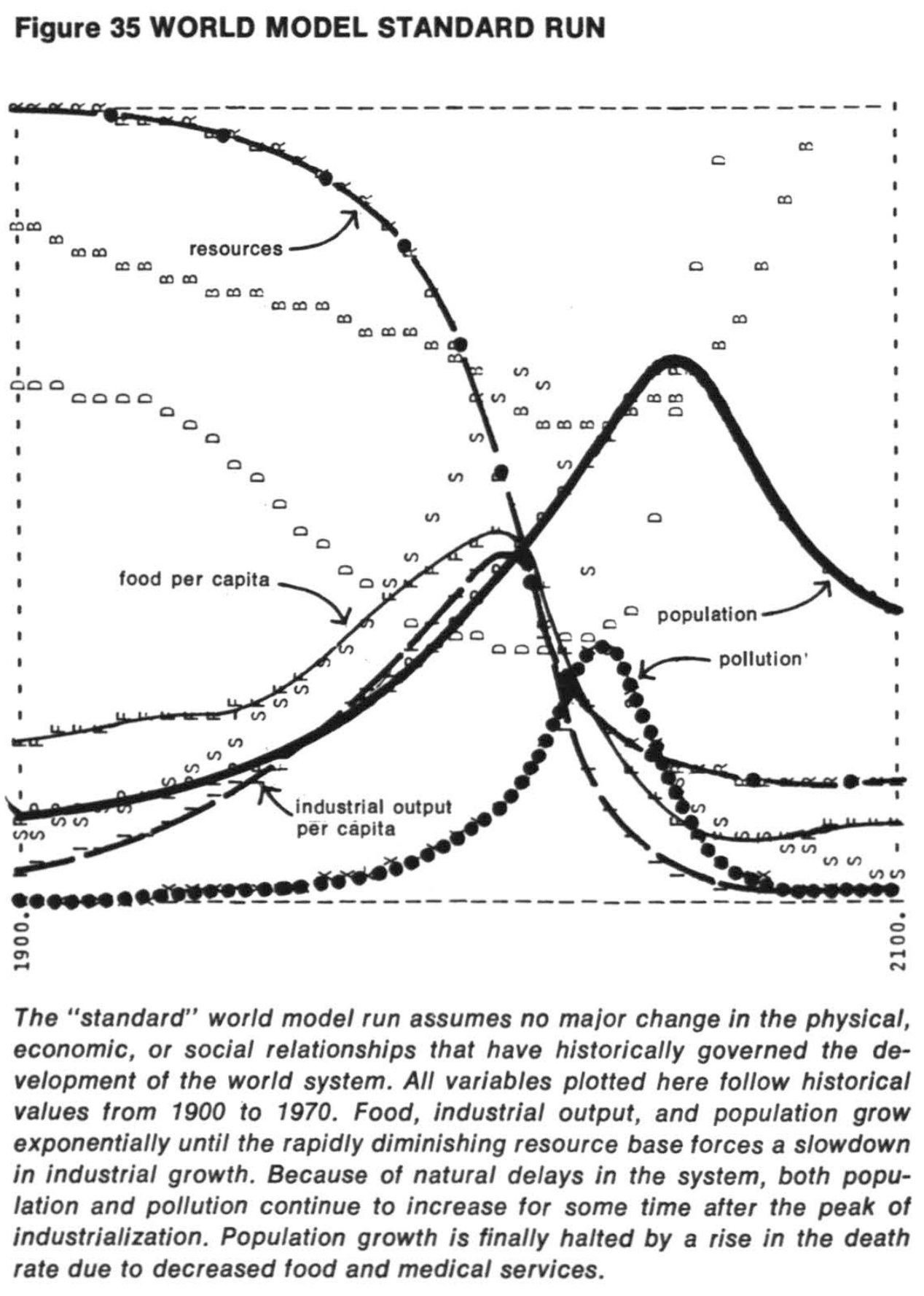The Climate #8: Playing with fire
Can our forest ecosystems survive a hotter, drier climate?
As humanity continues to ignore a path to sustainability, the question is not whether we have overshot Earth's capacity to support us, but by how much. A recent revisit to the Club of Rome's Limits to Growth models suggests global population and resource extraction peaks this decade. After that...?
Perhaps Ghandi was right at the time when he said:
‘The world has enough for everyone's need, but not enough for everyone's greed’.
And it would probably also have been right at any time since the evolution of modern humans until the middle of the 20th Century; when the world population breezed past 2 Billion. However, as the population touches 8 Billion in the next few months, ‘enough for everyone’s need’ may longer be the case. The reason for this is overshoot.

The best ever explanation of overshoot I have ever found is the brilliant essay by B. Sidney Smith. Below is a short excerpt:
“Suppose we start with 10 breeding pairs of bunnies living in a fenced meadow. There is no such thing as an infinite meadow: every meadow produces just so much food and water, and has just so much space. Suppose for the sake of the example that this is a large meadow that continuously produces enough food and water and contains enough space to support a thousand rabbits. Now the doubling time for populations of rabbits under ideal conditions is about 3 months, or 1 season, so they double their number 4 times per year. Thus after the first year our starting population of 20 rabbits has doubled 4 times, from 20 to 40, then to 80, then to 160, then to 320. So the second year starts with 320 rabbits. How many rabbits are there at the start of the third year?
The correct answer is 0. At the start of the third year there are no rabbits in the meadow at all. Not only that, the meadow is gone too. This is because the rabbits’ population went into overshoot. In the first three months of the second year their numbers doubled from 320 to 640 and everything was going along fine. By midyear they had doubled again, to 1,280, and were eating up the available food faster than the meadow was regrowing it. Things were getting crowded too, but there was no panic; all the rabbits were still getting enough to eat, even though all the fresh, green shoots were gone and everybody had to eat the tough, older leaves and stems. But by the autumn the population had doubled again, to 2,560—far more than the meadow could support. Having eaten all the leaves, the rabbits ate the stems down to the ground. As they began to starve, in desperation they dug up the roots and ate those. In the end they ate each other. When the last rabbit died from starvation, it died in a desert.”
It is pretty stark and worth re-reading, but unfortunately it is a reasonable analogy to what we are doing to our planet. Gaia can support only so many people, yet we have grown our population beyond what Gaia can reasonably be expected to support.
Another way of looking at our consumption is to estimate how long it takes each year to consume our meadow’s available resources for the year. This is known as our ecological footprint. We know each year we consume a certain amount of non-renewable resources like minerals and fossil fuels and renewable resources like water and food. We also produce waste (including CO2 from our fossil fuel burning) and turn productive spaces and soils into bitumen, concrete and eroded deserts. In 1970, World Overshoot Day, the day when we started taking resources from future years rather than 1970 was 29 December. In 2021 it was 29 July. That is, in 2021 we consumed all our world can provide in a year in not much more than half a year. We are down to the tough older leaves and stems.
One of the more important ‘plants’ in our meadow is access to cheap, easy to extract energy. However, we have consumed most of the best of that (aka oil) and are now increasingly reliant on difficult and expensive to extract energy that returns far less available energy to use when compared to the effort and energy to extract it; as explained in my first post in this thread (Why peak everything?).
Although concerns about resource availability may have raised eyebrows a century ago, by the late 1960s and early 1970s, a group of forward thinkers collaborating as the Club of Rome started seriously discussing and modelling the likelihood of global overshoot. They produced a seminal book – ‘Limits to Growth’, published in 1972, that has at various times in the roughly six decades since publication been either lauded or pilloried. However, the main thing I took away from it when I recently read it again was just how accurate it was in predicting the predicament we are in right now.
Dennis Meadows and his colleagues used the modelling technique known as system dynamics to model several scenarios evaluating the relationships between different rates of resource consumption, industrial output, food production, pollution creation and human population growth for the planet as a whole. These relationships are complex and feed back upon each other. For example, high rates of population growth tend to result in high rates of resource depletion and high rates of pollution creation, which together limit further population growth.
The models created a great deal of controversy because they forecast that if we didn’t change our ways (known as the business as usual or ‘standard run’ scenario) we were heading for a population collapse due to resource exhaustion and declining food production in the second half of this century; with the world population forecast to peak in the third decade - that is - around about now!

Earlier this year (2021), Gaya Herrington revisited the models, updating them with the most recently available data. As illustrated in the diagrams below (BAU = business as usual), she came to essentially the same conclusions as the Club of Rome collaborators did in 1972. That is, if we don’t change our ways, we reach peak population overshoot this decade.

She modelled additional scenarios that include BAU2 - where we discover/double available natural resources - but this results in only a slight delay before the population collapses owing to excessive pollution (think climate change due to atmospheric CO2).
The 'CT 'scenario (comprehensive technology) in the diagram suggests a fairly stable population assuming technology saves us. Ideally, but perhaps least likely, is the SW scenario (stabilised world) where, not only are we aided by technology, but we radically change human behaviour and put such values as equity, welfare and particularly sustainability above all others - in stark contrast to the business as usual scenario we have been closely tracking since 1972.
The Limits to Growth models are just one set of many models developed to inform our understanding and assist decision making about the future. The aphorism 'all models are wrong, but some models are useful' should always be borne in mind. The clarity, elegance and above all the performance of the models to date is why I place the Limits to Growth models in the useful category.
Other models give estimates of the **true** human carrying capacity of the earth that vary widely. These range from only a billion or so, to 10 times our current population of nearly 8 billion. The median estimates (based on LOTS of assumptions) are around the number we are now or a couple of billion more. But there is a catch. Going back to Ghandi – if we all live as frugally as a vegetarian, mid-20th century Indian villager then perhaps yes, eight or even twelve billion might be fine. But are we and our current economic and political systems designed to trend down our consumption in that direction, or increase consumption (whether we 'need' to or not)? Something to think about...
I think I will leave this post there. Clearly the question of overshoot raises a number of issues that need to be explored further. I look forward to sharing these explorations via subsequent posts in the very near future. In the meantime, feel free to take in some light-hearted self reflection linked below....

Limits to Growth Revisited is a conversation with Dennis Meadows looking back and forward at the work recorded by Daniel Wahl in August 2020.
Jared Diamond's Collapse is well known, enjoyable to read and a wide ranging discussion of the dilemmas faced by past civilisations faced with overshoot and several other threats.
This article in the Atlantic is a doorway into Peter Turchin's deep and detailed body of work examining the the social and political consequences of a range of civilisational stressors/overshoot.
John B Calhoun's mice experiments in the 1960s are interesting, particularly the behaviour of 'passive' mice in an extreme overcrowding state. Makes me think about the Chinese youth phenomenon of lying flat.
For those who haven't had much experience with System Dynamics modelling but are keen to learn more, AnyLogic offers excellent SD tools within its comprehensive simulation package (free for personal use), combined with great tutorials and examples.
Subscribe to thisnannuplife.net FOR FREE to join the conversation.
Already a member? Just enter your email below to get your log in link.